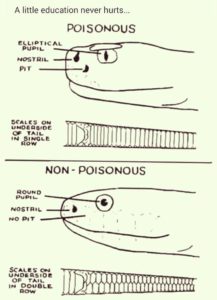 This diagram has been floating around the internet for several years, and has a habit of becoming viral at least a few times a year. Since it has been making the rounds again I thought I would address this once and for all.
This diagram has been floating around the internet for several years, and has a habit of becoming viral at least a few times a year. Since it has been making the rounds again I thought I would address this once and for all.
THE GOOD
Well, actually, before we begin let me get this out of the way ; the term poisonous is used in this diagram and often causes an uproar. The fact is both venomous and poisonous have been used interchangeably for decades by biologists. Many older, and some recent, publications still use poisonous when referring to snakes. It’s not that big of a deal as long as the average person gets the point. So, with that out of the way, let’s discuss the rest.
From what I understand, this diagram was from a book on local snake species somewhere in the U.S. In fact, the diagram is accurate for many areas of country. Venomous pit vipers (top drawing) do have a pit in between the nostril and eye. Pit vipers also do have a single row of scales on the underside of the tail (called subcaudals). As far as the Non-venomous snake goes ; it is correct that they do not have a pit like a pit viper does, but this can cause confusion and possibly be dangerous…
THE BAD
The main problem with this diagram is that many people are assuming that it covers all snakes on Earth. This is a dangerous and erroneous line of thinking. Fact is this diagram doesn’t even cover all snakes in the United States. The glaring error is that venomous Elapids have round pupils and no heat-sensing pits on the face. This includes the three native U.S. coralsnake species as well as some of the most venomous snakes in the world, such as Africas’ Black Mamba (Dendroaspis polylepis) and the most venomous snake, Australias’ Inland Taipan (Oxyuranus microlepidotus). In general, pupil shape and subcaudal scales are not the best way to determine what type of snake you are looking at. Realistically, the average person isn’t going to get close enough to see pupil shape or examine scales. To throw another wrench into things, many harmless snakes have “cat” pupils, and venomous pit vipers can have round pupils under certain light conditions. Pupil shape normally indicates what time of day snakes are hunting, not whether or not they are venomous. (see this article).
CONCLUSION
The corrupt power of the internet has taken this diagram completely out of context. I’ve seen it posted dozens of times in a few days and have seen it used to “educate” people about snakes. I reiterate ; this diagram can be dangerous and can result in someone getting bit by a venomous snake. With this article we can hopefully counter the misinformation and prevent a painful and possibly fatal snakebite from happening.
Identifying snakes takes time, practice, and experience. We simply cannot rely on only one or two features, diagrams, rhymes, colors, patterns, eyes, etc. Instead, we must learn to use all of those features and recognize the snake as a whole. The most important thing to remember? If you cannot accurately identify a snake, leave it alone!
Another one bites the dust.